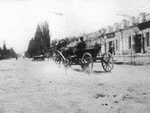 |
| source: ruwikipedia.ru |
The history of Bishkek begins with the legends. Kyrgyz people are great storytellers. They wrapped their capital in so many legends and stories that you can't help admiring the people's imagination. According to basic legend, Bishkek was the name of a mythical batyr (knight), who united various tribes of Kirghiz and founded the ancient city.
In 2003 Bishkek celebrated its 125th anniversary. However, according to the local historians, the city is much older than this «official» age. Archaeological findings indicate the urban life existence of this place as long ago as the 7th – 8th centuries. The devastating Mongol invasion in the 13th century destroyed the ancient centers of civilization. It was only in 1825 that the Kokand people erected the fortress of Pishpek (distorted Bishkek) on that place to oppress the local population and to protect the caravan routes to Tashkent. The expulsion of the militant Kokandians succeeded only with the help of Russian troops during the Central Asia conquests of imperial Russia. After the fall of the fortress the whole territory of the Chuy valley became a part of the Russian state.
In 1878, the small village of Pishpek grew up on the site of the destroyed Kokand fortress and became a district town. In 1924, when Kara-Kirghiz Autonomous Region was formed within the Russian Federation, Pishpek became the capital of the autonomy. A year later, the autonomy was renamed the Kirghiz, and a year later already Pishpek changed its name to the sonorous Frunze in the honor of the native of the city, the Soviet commander Mikhail Vasilyevich Frunze. Only in 1992, the capital of independent Kyrgyzstan was returned its original name, Bishkek.
Back in 1878 the government approved the plan of urban development, according to which the ugly little village with yurts and dirty mud huts was to be transformed into a beautiful European city with a rectangular layout of wide streets and avenues, numerous parks, alleys, squares ... That is how we see Bishkek today. Although the ancient monuments in the city are scarce, they are compensated with very interesting architectural samples of the beginning of the 20th century.

